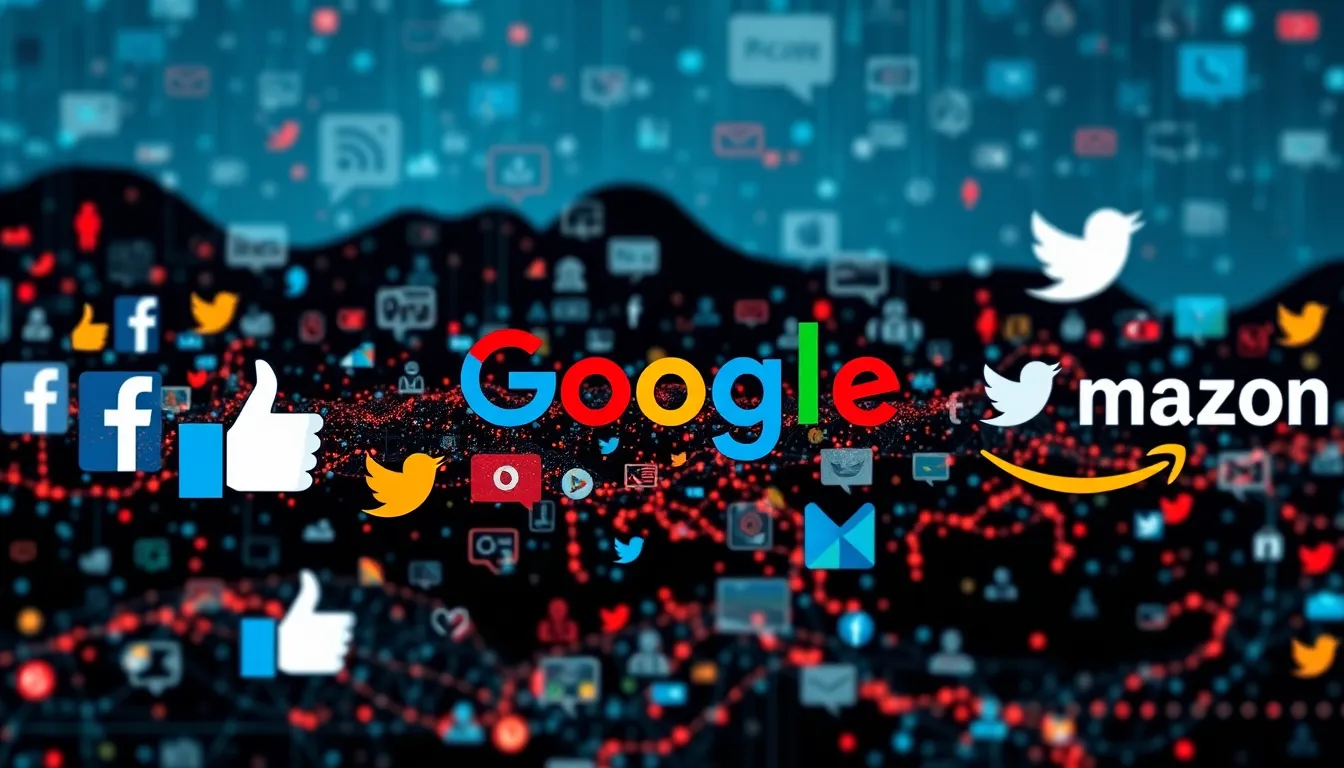In a world where social media feels like the wild west, big tech companies are the sheriffs, cowboys, and sometimes the bandits. They wield immense power over what trends, what goes viral, and even what gets buried in the digital dust. With every like, share, and scroll, they’re shaping our online interactions in ways most users don’t even realize.
From algorithms that decide what content you see to targeted ads that know you better than your best friend, big tech is the puppet master pulling the strings. But is this a good thing? As platforms evolve and our feeds become more curated, understanding the influence of these tech giants is crucial. Buckle up as we dive into how big tech is not just a player in the social media game but the one calling the shots.
Table of Contents
ToggleOverview of Big Tech’s Influence
Big tech companies significantly shape social media dynamics. These firms, including Facebook, Google, and Twitter, leverage sophisticated algorithms that curate content to enhance user engagement. A user’s feed often reflects the company’s focus on maximizing interactions, often prioritizing sensational or trending topics.
Control over algorithms enables these companies to influence what information users encounter. By strategically highlighting specific posts, they determine which content becomes viral, subtly steering public discourse. Although users may not realize it, targeted advertising delivers tailored messages based on browsing history and behavioral patterns, enhancing engagement and sales for advertisers.
Privacy concerns arise from big tech’s data collection practices. User data facilitates the creation of detailed profiles that advertisers can use for precise targeting. Many users remain unaware of the extent of data gathering, leading to debates about ethical practices in the industry.
Social media platforms grow increasingly curated as big tech continues to assert its influence. Decisions on what content is amplified, restricted, or banned reflect the companies’ interests. A clear power imbalance exists where a handful of companies dictate the terms of engagement, shaping users’ online experiences.
Trends emerge based on the content these companies promote. Viral phenomena can arise from algorithmic pushes that amplify certain ideas or trends while suppressing others. Understanding how this dynamic operates is crucial as social media continues evolving, highlighting the necessity of scrutinizing big tech’s role in shaping public perceptions and interactions.
Key Players in Big Tech

Big tech companies play a pivotal role in shaping social media dynamics and user experiences. Understanding these players reveals the structure of influence within the digital landscape.
Major Companies
Facebook, Google, Twitter, and Amazon represent some of the most influential players in big tech. Facebook dominates social networking with its vast user base, while Google leads in search and online advertising. Twitter facilitates real-time information sharing, garnering significant engagement. Amazon, primarily an e-commerce giant, also impacts social media through advertising and content distribution. Each company employs advanced algorithms to curate content and direct user interactions, effectively steering conversations and trends across various platforms.
Market Shares and Influence
Together, these companies constitute a significant market share in the digital advertising sector. Facebook holds approximately 23% of global ad revenue, while Google commands nearly 29%. Twitter’s market share is smaller, hovering around 5%, yet its real-time engagement remains crucial for breaking news and trends. These numbers underline their substantial influence over the way information circulates. Users’ daily interactions with content are heavily influenced by the advertising strategies these firms implement. Consequently, the power these companies wield significantly shapes public discourse and user engagement online.
Mechanisms of Influence
Big tech companies exert considerable influence over social media through various mechanisms, primarily algorithms and advertising strategies.
Algorithms and Content Curation
Algorithms play a crucial role in determining which content appears in users’ feeds. These algorithms analyze numerous variables, such as user behavior and engagement patterns, to curate individualized experiences. Facebook’s algorithm prioritizes posts that encourage interactions, often boosting sensational topics to maximize click-through rates. Google employs similar techniques to ensure search results reflect trending keywords and user interests. Users may find that their feeds consistently showcase high-engagement content, leading to a narrow view of available information. This curation process subtly directs public discourse, emphasizing topics deemed popular while diminishing others.
Advertising Power
Advertising strategies employed by big tech firms significantly shape social media engagement. These companies dominate the digital advertising market, with Facebook holding roughly 23% and Google capturing nearly 29% of global ad revenue. Such substantial market shares allow these platforms to implement targeted advertising that reaches specific demographics. Advertisements are often crafted based on user data, which creates tailored experiences that resonate with individual interests. As a result, many users encounter promotional content that aligns closely with their online behaviors. This targeted approach not only boosts engagement but also transforms users into crucial components of the advertising ecosystem.
Impact on Social Media Dynamics
Big tech companies wield considerable influence over social media, shaping user experiences and interactions in profound ways. Their control significantly affects how content is created and consumed.
User Engagement and Behavior
Platforms like Facebook and Google prioritize engagement by utilizing sophisticated algorithms. These algorithms curate individualized content based on user behavior, increasing the likelihood of interaction. Users often encounter posts that provoke strong reactions or spark conversations, leading to a cycle of amplified visibility. User engagement metrics rely heavily on interactions that reflect momentary trends, creating an environment where sensational content thrives. The drive for clicks and shares means that users frequently engage with topics deemed popular, often at the expense of diverse viewpoints. Understanding how engagement shapes behavior helps users navigate their experiences within these platforms.
Misinformation and Content Moderation
Misinformation flourishes in the digital landscape influenced by big tech. Content moderation strategies aim to counteract this trend, yet these tactics sometimes backfire. Algorithms struggle to distinguish between factual information and misleading content, leading to the amplification of false narratives. Companies face scrutiny over their content moderation policies, which can inadvertently suppress legitimate expressions. Transparency about these practices remains critical, as users deserve clarity on how their information is governed. Ongoing debates focus on finding the balance between free expression and the need for accurate information, as the stakes continue to rise in the social media landscape.
Regulation and Ethical Considerations
Big tech’s influence on social media prompts discussions around regulation and ethical responsibilities. Governing bodies are increasingly scrutinizing these companies to balance innovation and public interest.
Government Interventions
Government interventions emerge as critical responses to big tech’s power. Legislators worldwide propose regulations aimed at data privacy, such as the General Data Protection Regulation (GDPR) in Europe. These policies seek to protect user information from exploitation. In the United States, various states have introduced or considered legislation targeting privacy practices in social media networks. Regulatory measures aim to hold companies accountable for misinformation, requiring them to develop more effective content moderation strategies. Comprehensive approaches to regulation can help create more transparent platforms and better user experiences.
Ethical Responsibilities
Ethical responsibilities shape how big tech interacts with users and society. Companies must prioritize user privacy by implementing robust data protection measures. Transparency about data usage builds trust, enabling users to make informed choices. Furthermore, platforms should actively combat misinformation by establishing clear content guidelines that promote accuracy and accountability. Engagement strategies that prioritize sensational content often undermine users’ exposure to diverse viewpoints. Balancing user engagement with ethical considerations may create healthier online environments and foster meaningful interactions.
Big tech’s influence on social media is profound and multifaceted. Their algorithms and advertising strategies not only shape what users see but also dictate how they engage with content. As these companies continue to wield significant power over public discourse, the implications for privacy and misinformation are increasingly concerning.
The ongoing discussions around regulation and ethical responsibilities highlight the urgent need for transparency and accountability. Users deserve clarity on how their data is used and how content is moderated. Striking a balance between user engagement and ethical considerations is crucial for fostering healthier online environments. As the digital landscape evolves, the role of big tech will remain a pivotal factor in shaping social media’s future.




